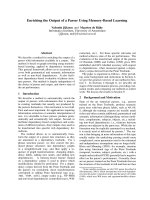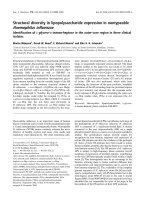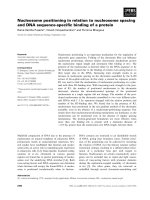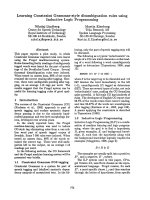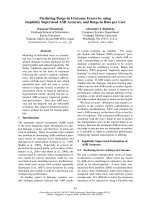Báo cáo khoa hoc:" Genetic diversity in Spanish donkey breeds using microsatellite DNA markers" potx
Bạn đang xem bản rút gọn của tài liệu. Xem và tải ngay bản đầy đủ của tài liệu tại đây (241.21 KB, 10 trang )
Genet. Sel. Evol. 33 (2001) 433–442 433
© INRA, EDP Sciences, 2001
Original article
Genetic diversity in Spanish donkey
breeds using microsatellite DNA markers
José A
RANGUREN
-M
ÉNDEZ
a, b
, Jordi J
ORDANA
a, ∗
,
Mariano G
OMEZ
c
a
Unitat de Genètica i Millora Animal, Departament de Ciència Animal i dels
Aliments, Facultat de Veterinària, Universitat Autònoma de Barcelona,
08193-Bellaterra, Barcelona, Spain
b
Universidad del Zulia, Facultad de Ciencias Veterinarias, Departamento de
Producción Animal, Maracaibo 4001-A, Venezuela
c
Servicio de Ganadería, Diputación Foral de Bizkaia, Avda. Lehendakari Aguirre,
9, 2
◦
, 48014 Bilbao, Spain
(Received 27 November 2000; accepted 23 April 2001)
Abstract – Genetic diversity at 13 equine microsatellite loci was compared in five endangered
Spanish donkey breeds: Andaluza, Catalana, Mallorquina, Encartaciones and Zamorano-
Leonesa. All of the equine microsatellites used in this study were amplified and were
polymorphic in the domestic donkey breeds with the exception of HMS1, which was mono-
morphic, and ASB2, which failed to amplify. Allele number, frequency distributions and mean
heterozygosities were very similar among the Spanish donkey breeds. The unbiased expected
heterozygosity (H
E
) over all the populations varied between 0.637 and 0.684 in this study.
The low G
ST
value showed that only 3.6% of the diversity was between breeds (P < 0.01).
Significant deviations from Hardy-Weinberg equilibrium were shown for a number of locus-
population combinations, except HMS5 that showed agreement in all analysed populations. The
cumulative exclusion probability (PE) was 0.999 in each breed, suggesting that the loci would
be suitable for donkey parentage testing. The constructed dendrogram from the D
A
distance
matrix showed little differentiation between Spanish breeds, but great differentiation between
them and the Moroccan ass and also with the horse, used as an outgroup. These results confirm
the potential use of equine microsatellite loci as a tool for genetic studies in domestic donkey
populations, which could also be useful for conservation plans.
donkey / endangered breed / microsatellite / diversity / genetic variability
1. INTRODUCTION
The local Spanish donkey breeds (Equus asinus) Andaluza, Catalana,
Encartaciones, Mallorquina and Zamorano-Leonesa have suffered a substan-
tial decrease in population size which might cause high levels of inbreeding
∗
Correspondence and reprints
E-mail:
434 J. Aranguren-Méndez et al.
resulting in inbreeding depression and increasing the risk of breed extinc-
tion. The principal cause of the great reduction in population size of up to
80% has been the intense mechanisation of agriculture which took place in
Spain during the 60s and the 70s. These Spanish donkey breeds have been
officially recognised as breeds for a long time. Currently, the number of
animals recorded among these five breeds is very low, and they are included
in the FAO (Food and Agriculture Organisation of the United Nations) list of
domestic animal breeds to be conserved (FAO, DAD-IS />is). At present, the Spanish donkey breeds comprise approximately 100
to 200 females each (Breed Associations personal communications). These
figures fit into the category of an endangered breed as proposed by the FAO
Expert Consultation [2]. Without immediate action, the effective population
size of these five Spanish breeds will be inadequate to prevent constant genetic
loss at each generation [8].
The origin of the modern Spanish donkey breeds remains uncertain. Accord-
ing to several authors [1,12,13,15] current Spanish donkeys seem to derived
from two ancestral sources: the Nubian ass (Equus asinus africanus), which
gave rise to the Andaluza breed [3,16,40], and secondly, the Somalian ass
(Equus asinus somaliensis) which gave rise to the donkeys of Southwest
Asia and probably also to the majority of European breeds, among which
the Catalana, Mallorquina, Encartaciones and Zamorano-Leonesa breeds [15].
Notwithstanding this, Dechambre and Sanson, as cited by several authors [3,
24,37,40], support the theory of two different ancestral sources: one which
would correspond to the Equus asinus africanus, originating from Northeast
Africa, and the other one, the Equus asinus europeus, whose area of origin is the
Mediterranean Basin, in particular the Balearic Isles, which would have given
rise to the majority of European donkey breeds, including the four Spanish
breeds mentioned in the previous paragraph.
The conservation of genetic variation found in these minor livestock breeds
is a growing world-wide concern due to the increasing risk of breed loss.
Recently, many studies of breed conservation have used allele frequencies for
several DNA markers, such as microsatellites [19, 26,36].
Very little literature reporting microsatellite data in domestic donkeys exists;
only Breen et al. [10], using a set of 13 microsatellite loci isolated from
the domestic horse, verified that they were well-amplified in eight individu-
als. In addition, Bellone and co-workers [7] reported studies in one French
donkey breed (Baudet du Poitou) with nine microsatellite loci. Finally, we
also performed studies with the Catalonian donkey breed [22,23]. In the
present work, 15 equine microsatellite loci were analysed in 5 Spanish donkey
breeds, in order to study the genetic variability both within and between these
breeds.
Genetic diversity in Spanish donkey breeds 435
Figure 1. Geographical location of the Spanish donkey breeds.
2. MATERIALS AND METHODS
2.1. Population samples
The number of individuals sampled, of both sexes, was 87 Andaluza (AND),
140 Catalana (CAT), 104 Mallorquina (MALL), 74 Encartaciones (ENC) and
108 Zamorano-Leonesa (ZAM) representing 75 and 95% of the whole popu-
lation in each case. The area of main distribution of these indigenous Spanish
breeds is shown in Figure 1. In addition, 9 Moroccan asses (MOR) were used
as genuine members of E. asinus africanus, and 24 horses of the Merens breed
(E. caballus) were used as an outgroup. Donkey DNA was prepared from
whole blood according to standard methods involving lysates of the washed
white-cells and phenol-chloroform-isoamylalcohol (25:24:1) extraction [4].
2.2. Microsatellite markers
The 15 microsatellite loci studied were AHT4, AHT5 [6], ASB2 [11],
HMS1, HMS2, HMS3, HMS5, HMS6, HMS7 [17], HTG4, HTG6 [14], HTG7,
HTG10 [25], HTG15 [5] and VHL20 [41].
436 J. Aranguren-Méndez et al.
2.3. Multiplex PCR conditions
The 15 microsatellites were amplified in three multiplexes using
fluorescently-labelled primers. The first multiplex included microsatellites
ASB2, HMS3, HMS6, HTG6, HTG10, and VHL20. The second was composed
of AHT4, AHT5, HMS2, HMS7 and HTG7, while the third contained HMS1,
HMS5, HTG15 and HTG4. Multiplex PCRs were carried out in 15 µL reactions
containing 30 ng of genomic DNA, 200 µM of dNTP, 0.5 µL of AmpliTaq
Gold (5 U · µL
−1
), 1.5 mM of MgCl
2
and 0.5 µL of each primer (AHT4,
ASB2, HMS2, HMS3, HTG6, HTG7, HTG10), 0.4 µL of the primer (AHT5,
HMS6 and HMS7) while 0.3 µL of primer VHL20 (StockMarks
R
for Horses,
Equine Paternity PCR Typing Kit, PE Applied Biosystems, Foster City, CA),
and finally, 0.20 µM of primers HMS1, HMS5, HTG4 and HTG15. PCR
was carried out in a 9 700 GeneAmp PCR system (Perkin Elmer) by an initial
denaturation at 95
◦
C for 10 min, followed by 30 cycles at 95
◦
C for 30 s, 60
◦
C
for 30 s and 72
◦
C for 60 s. The thermal profile ended with a final extension
at 72
◦
C for 60 min. PCR products were detected by capillary electrophoresis
using an Applied Biosystems 310 DNA Sequencer with GENESCAN Analysis
software (ABI), using the ROX 350 bp internal-size standard.
2.4. Statistical analyses
Allele frequencies (available from the authors on request) and mean hetero-
zygosity values for each polymorphic locus were obtained using the BIOSYS-2
computer programme [38]. The test of genotype frequencies for deviation from
the Hardy-Weinberg Equilibrium (HWE) was calculated using the exact test
of the GENEPOP 3.1d computer programme [32], using the Markov-chain
method [18]. Polymorphic information content (PIC) was calculated for each
microsatellite locus according to Botstein et al. [9], and the probability of
exclusion (PE) was determined for all informative markers [20].
The average expected heterozygosity for each population (H
S
), the gene
diversity in the total population (H
T
), and the coefficient of gene differentiation
G
ST
[27] were estimated using the computer programme DISPAN [30], and
tested by permutation test. Differences in average heterozygosities among
breeds were assessed using the ANOVA test of the SAS
R
package [35].
Genetic distances and phylogenetic trees among populations were obtained
with the distance measure D
A
[29]. Takezaki and Nei [39] suggested the D
A
distance for making phylogenetic trees when the interest of the study mainly
focused on the topology rather than evolutionary time. Distance data was
analysed with the neighbour-joining (NJ) method of clustering [34]. The NJ
method produces only unrooted trees. For this reason we included the data for
the Merens breed population as an outgroup to root the tree. The robustness of
the dendrogram was evaluated by bootstrap resampling of loci (1 000 replic-
ates). All these calculations were carried out using the DISPAN package [30].
Genetic diversity in Spanish donkey breeds 437
Table I. Total number and range of observed alleles, average heterozygosity H
S
and
H
T
, coefficient of differentiation G
ST
, PIC and PE, in Spanish donkey breeds.
Microsatellite No.A.
1
S. Range
2
H
T
H
S
G
ST
PIC
3
PE
4
AHT4 15 126–160 0.773 0.753 0.031
∗∗∗
0.71 0.55
AHT5 14 126–156 0.907 0.852 0.037
∗∗∗
0.85 0.74
ASB2 – – – – – – –
HMS1
A
1 165 – – – – –
HMS2 10 229–247 0.709 0.714 0.016
∗∗∗
0.65 0.47
HMS3 7 152–170 0.618 0.603 0.044
∗∗∗
0.51 0.32
HMS5 3 105–109 0.278 0.336 0.109
∗∗∗
0.20 0.10
HMS6 6 151–167 0.649 0.613 0.041
∗∗∗
0.54 0.33
HMS7 7 165–177 0.626 0.601 0.031
∗∗∗
0.53 0.33
HTG4 5 167–175 0.495 0.439 0.048
∗∗∗
0.40 0.21
HTG6 11 76–102 0.817 0.714 0.053
∗∗∗
0.73 0.55
HTG7 13 134–164 0.843 0.800 0.030
∗∗∗
0.80 0.65
HTG10 12 85–107 0.837 0.790 0.035
∗∗∗
0.78 0.63
HTG15 7 116–136 0.751 0.746 0.014
∗∗∗
0.70 0.51
VHL20 4 75–99 0.579 0.597 0.035
∗∗∗
0.50 0.31
All loci 0.683 0.658 0.036
∗∗∗
0.999
(±0.170) (±0.147) (±0.023)
∗∗∗
P < 0.001.
1
Total number of observed alleles. –: Failed to amplify.
2
Size range of the observed allele in bp.
3
Polymorphism information content.
4
Exclusion probability.
A
: Monomorphic.
3. RESULTS
The equine microsatellites were all well-amplified in the donkey, with the
exception of locus ASB2, which failed to amplify. All amplified loci were
polymorphic except HMS1, which was monomorphic (165 bp) in all breeds.
The number of alleles varied between 3 (HMS5) and 15 (AHT4) (Tab. I), with
generally little difference between the breeds (data not shown). The average
gene diversity H
T
[27] over all loci was 0.683 ± 0.170 while, for individual
loci, it ranged from 0.278 (HMS5) to 0.907 (AHT5).
The average expected heterozygosity H
S
across all loci in the total sample
was 0.658 ± 0.147 and ranged from 0.336 (HMS5) to 0.852 (AHT5). The
average coefficient of gene differentiation (G
ST
) over the 13 loci was 0.036 ±
0.023 (P < 0.01). The G
ST
values for single loci ranged from 0.014 for HTG15
to 0.109 for HMS5. The PIC and the exclusion probability (PE) are given in
Table I. The combined probability of exclusion was 0.999, across the whole
sample as well as for each breed.
438 J. Aranguren-Méndez et al.
Table II. Sample size, number of alleles per locus and heterozygosity (± standard
errors) averaged over 13 microsatellites in 5 donkey populations.
Mean heterozygosity
Population Mean sample
size per locus
Mean No. of
alleles per locus
Observed Expected
∗
Andaluza 87 7.0 ± 1.0 0.532 ± 0.052 0.679 ± 0.034
Catalana 140 7.1 ± 1.0 0.528 ± 0.062 0.663 ± 0.055
Mallorquina 104 7.5 ± 0.9 0.570 ± 0.063 0.637 ± 0.054
Encartaciones 74 7.4 ± 1.0 0.564 ± 0.066 0.646 ± 0.059
Zamorano-Leonesa 108 7.3 ± 1.1 0.539 ± 0.058 0.684 ± 0.044
Means 7.2 ± 1.0 0.546 ± 0.060 0.654 ± 0.048
∗
Unbiased estimate [28].
Among Spanish donkeys the mean number of alleles per locus ranged from
7.0 in the Andaluza breed to 7.5 in the Mallorquina breed (Tab. II). The
mean observed heterozygosity (H
O
) showed a range of values from 0.528
in the Catalana breed to 0.570 in the Mallorquina breed. Average expected
heterozygosities (H
E
) ranged from 0.637 in the Mallorquina breed to 0.684
in the Zamorano-Leonesa breed, and were not significantly different. The
number of private alleles varied among the five breeds: 1 in Andaluza (HMS6:
151 bp), 4 in Encartaciones (one in HTG4: 175 bp; AHT4: 146 bp; and
two in HTG6: 98 and 100 bp), 2 in Mallorquina (HMS3: 160 bp; HTG15:
136 bp) and one in Zamorano-Leonesa (HTG4: 173 bp). Only one private
allele showed a frequency > 5% (HTG6; 100 bp with a frequency of 10.8%,
in the Encartaciones breed).
HWE was tested for all breed-locus combinations. Of the 65 contrasts,
48 tests gave significant deviations from HWE showing a significant hetero-
zygote deficit. Only 17 tests showed agreement with HWE, corresponding to
the Andaluza, Encartaciones and Mallorquina breeds for four microsatellites
(HMS3, HMS5, HTG6 and VHL20; HMS3, HMS5, HTG10 and VHL20; and
AHT4, HMS3, HMS5 and HMS6, respectively), the Zamorano-Leonesa breed
for three microsatellites (HMS5, HTG10 and VHL20) and the Catalana breed
for two microsatellites (HMS5 and HTG15). Only one of the microsatellites
(HMS5) showed agreement with H-W proportions in all analysed populations.
The D
A
distance, using 13 microsatellites, ranged between 0.057 and 0.093
for the Spanish donkey breeds (Tab. III). A neighbour-joining tree was con-
structed, and the reliability of the obtained tree was examined by 1 000 bootstrap
replicates (Fig. 2). The most robust features of the topology were the Catalana-
Mallorquina cluster (70% support) and the cluster (77% support) formed by
Andaluza and the four black coated breeds (CAT, ENC, MALL and ZAM)
which are all from the North of Spain.
Genetic diversity in Spanish donkey breeds 439
Table III. Matrixof D
A
genetic distanceamongfive Spanish donkey breeds(Moroccan
ass and horse).
AND CAT MALL ENC ZAM Horse
Moroccan 0.119 0.197 0.154 0.136 0.123 0.685
Andaluza 0.093 0.078 0.063 0.057 0.629
Catalana 0.069 0.071 0.079 0.665
Mallorquina 0.067 0.062 0.649
Encartaciones 0.059 0.640
Zamorano-Leonesa 0.644
Figure 2. Dendrogram showing the genetic relationships among donkey breeds
using the neighbour-joining method and the D
A
genetic distance, measured with
13 microsatellite loci. The number at the forks indicate the percentage of group
occurrence in a bootstrap resampling of 1 000 trees.
The low genetic distances among Spanish breeds indicated a close relation-
ship among these populations. The phylogenetic tree was constructed based
on the matrix of D
A
values using the Merens horse breed as an outgroup, and
the Moroccan ass breed as the reference population for the Spanish breeds.
4. DISCUSSION
The average number of alleles and the expected heterozygosities (H
E
) were
similar for all breeds, indicating that there are no appreciable differences in
the level of genetic variability among the Spanish breeds. These results are
comparable to the previous values reported in Catalonian donkeys [23] and the
Baudet du Poitou breed [7].
440 J. Aranguren-Méndez et al.
Average genetic differentiation (G
ST
) among the breeds was 3.6%, a rel-
atively low but significant (P < 0.01) value. All loci were contributing to
that differentiation. The global PE value of 0.999 for each breed makes
it extremely unlikely that false parentage would not be recognised. These
markers are therefore an effective tool in donkey parentage verification. The
genetic relationships among the populations correspond with the geographical
distribution of the breeds studied. The dendrogram (Fig. 2) groups all of the
Spanish donkeys into one cluster (59% support).
Within the Spanish breeds, the four black coated populations (CAT, ENC,
MALL and ZAM) form a cluster (77% support), supporting the hypothesis
of a common ancestral past from E. a. europeus. The Catalana and Mallor-
quina breeds are the most closely related, supporting both the historic and the
archaeological evidence that they show common ancestry [31,33].
All sources agree that the Andaluza breed descended from the primitive ass of
North Africa (E. a. africanus) which could have been introduced into the South
of the Iberian Peninsula through the Straits of Gibraltar [3,13,15,37]. However,
our data fails to clearly position the Andaluza breed within our tree. Further
investigations involving more European and African donkey populations, as
well as the analysis of
mt
DNA, which could show a possible introgression of
African haplotypes into European populations would be useful to clarify this
point. Nevertheless, we have concluded that the analyses of genetic markers
such as microsatellite sequences are very valuable for the study of genetic
variability in donkey populations and to contribute to the establishment of their
own conservation plans [21].
ACKNOWLEDGEMENTS
This study was made possible by the financial support of the CICYT (project
AGF98–0503) and the DARP (Generalitat de Catalunya) ; we are also grateful
to the Breed Associations of Spanish donkeys for their helpful co-operation
and assistance during sample collection. Furthermore, we would like to thank
Chuck Simmons for the English revision and A. Clop, H. Yahyaoui and R.
Pena for suggestions on the manuscript.
REFERENCES
[1] Adametz L., Zootecnia General, Ed. Labor, Madrid, 1943.
[2] Anonymous, Recommendations of the FAO expert consultation, in: Hodges J.
(Ed.), The management of global animal genetics resources, Food and Agricul-
ture Organisation of the United Nations, Rome, 1992, pp. 1–24.
[3] Aparicio G., Zootecnia Especial. Etnología compendiada. Imprenta Moderna,
Córdoba, 1960.
Genetic diversity in Spanish donkey breeds 441
[4] Ausubel F.M., Brent R., Kingston R.E., Moore D.D., Seidman G.G., Smith J.A.,
Struhl K., Current protocols in molecular biology, Green Publishing Associates
and Wiley-Interscience, New York, 1987.
[5] Bailey E., Graves K.T., Cothran E.G., Reid R., Lear T.L., Ennis R.B., Synteny-
mapping horse microsatellite markers using a heterohybridoma panel, Anim.
Genet. 26 (1995) 80–111.
[6] Binns M.M., Holmes N.G., Holliman A., Scott A.M., The identification of poly-
morphic microsatellite loci in the horse and their use Thoroughbred parentage
testing, Brit. Vet. J. 151 (1995) 9–15.
[7] Bellone R.R., Cothran E.G., Ketchum M.S., Genetic variation in the rare donkey
breed, Baudet du Poitou, Anim. Genet. 29, (Suppl. 1) (1998) 17.
[8] Bodó I., The minimum number of preserved populations, in: Hodges J. (Ed.),
The management of global animal genetic resources, Food and Agriculture
Organisation of the United Nations, Rome, 1992, pp. 91–105
[9] Botstein D., White R.L., Skolnick M., Davis R.W., Construction of a genetic
linkage map in man using restriction fragment length polymorphisms, Am. J.
Hum. Genet. 32 (1980) 314–331.
[10] Breen M., Downs P., Irvin Z., Bell K., Intrageneric amplification of horse
microsatellite markers with emphasis on the Przewalski’s horse (E. przewalskii),
Anim. Genet. 25 (1994) 401–405.
[11] Breen M., Lindgren G., Binns M.M., Genetical and physical assignments of
equine microsatellites – First integration of anchored markers in horse genome
mapping, Mamm. Genome 8 (1997) 267–273.
[12] Camac R.O., Introduction and Origins of the Donkey, in: Svendsen E.D. (Ed.),
The professional handbook of the Donkey, 2nd edn., The Donkey Sanctuary,
Sidmouth, Devon, 1989, pp. 1–10.
[13] Clutton-Brock J., A natural history of domestic mammals, Vol. 2. Cambridge
University Press, Cambridge, 1987.
[14] Ellegren H., Johansson M., Sandberg K., Andersson L., Cloning of highly
polymorphic microsatellite in the horse, Anim. Genet. 23 (1992) 133–142.
[15] Epstein H., Ass, mule and onager, in: MasonI.L.(Ed.), Evolution ofdomesticated
animals, Longman, London and New York, 1984, pp. 174–184.
[16] García Dory M.A., Martínez S., Orozco F., Guía de campo de las razas autóctonas
españolas, Alianza Editorial, Madrid, 1990.
[17] Guerin G., Bertaud M., Amigues Y., Characterisation of seven new horse
microsatellites: HMS1, HMS2, HMS3, HMS4, HMS5, HMS6, HMS7, and
HMS8, Anim. Genet. 25 (1994) 62.
[18] Guo S.W., Thompson E.A., Performing the exact test of Hardy-Weinberg pro-
portions for multiple alleles, Biometrics 48 (1992) 361–372.
[19] Hancock J., Microsatellites and other simple sequences: genomic context and
mutational mechanisms, in: Goldstein D., Schlotterer C. (Eds.), Microsatellites.
Evolution and applications, Oxford University Press, New York, 1999, pp. 1–10.
[20] Jamieson A., The effectiveness of using codominant polymorphic allelic series
for (1) checking pedigrees and (2) distinguishing full-sib pair members, Anim.
Genet. 25 (1994) (Suppl. 1), 37–44.
[21] Jordana J., Folch P., The Catalonian donkey breed: program of conservation and
improvement of an endangered breed, Arch. Zootec. 47 (1997) 403–409.
442 J. Aranguren-Méndez et al.
[22] Jordana J., Folch P., Sánchez A., Genetic variation (protein markers and
microsatellites) in endangered Catalonian donkeys, Bioch. Syst. Ecol. 27 (1999)
791–798.
[23] Jordana J., Folch P., Aranguren J.A., Microsatellite analysis of genetic diversity
in the Catalonian donkey breed, J. Anim. Breed. Genet. 118 (2001) 57–63.
[24] Lorenzo J., Conocimiento y conservación de las razas autóctonas: “El asno
Zamorano-Leonés”estudio del estado actual de la raza en la provincia de Zamora;
valoración general: Aspectos biopatológicos y funcionales, Tesis Doctoral, Uni-
versidad de León, Spain, 1997.
[25] Marklund S., Ellegren H., Eriksson S., Sandberg K., Andersson L., Parentage
testing and linkage analysis in the horse using a set of highly polymorphic
microsatellites, Anim. Genet. 25 (1994) 19–23.
[26] Moazami-Goudarzi K., Laloë D., Furet J.P., Grosclaude F., Analysis of genetic
relationship between 10 cattle breeds with 17 microsatellites, Anim. Genet. 28
(1997) 338–345.
[27] Nei M., Analysis of gene diversity in subdivided populations, Proc. Natl. Acad.
Sci., USA 70 (1973) 3321–3323.
[28] Nei M., Estimation of average heterozygosity and genetic distance from a small
number of individuals, Genetics 89 (1978) 583–590.
[29] Nei M., Tajima F., Tateno T., Accuracy of estimated phylogenetic trees from
molecular data, J. Mol. Evol. 19 (1983) 153–170.
[30] Ota T., DISPAN: Genetic Distance and Phylogenetic Analysis, Pennsylvania
State University, University Park, PA, 1993.
[31] Payeras L., Falconer J., Races Autòctones de les Illes Balears, Govern Balear,
Palma de Mallorca, 1998.
[32] Raymond M., Rousset F., GENEPOP (Version 3.1): Population genetics software
for exact test and ecumenicism, J. Hered. 86 (1995) 248–249.
[33] Romagosa J.A., El Garañón Catalán, Tesis Doctoral, Universidad de Madrid,
Spain, 1959.
[34] Saitou N., Nei M., The neighbor-joining method: a new method for reconstruct-
ing phylogenetic trees, Mol. Biol. Evol. 4 (1987) 406–425.
[35] SAS
R
Institute Inc., SAS
R
User’s Guide: Statistics. Version 6.12. Cary, NC,
USA, 1996.
[36] Schmid M., Saitbekova C., Dolf G., Genetic diversity in Swiss cattle breeds, J.
Anim. Breed. Genet. 116 (1999) 1–8.
[37] Sotillo J.L., Serrano V., Producción Animal 1. Etnología Zootécnica. Tebar-
Flores, Madrid, 1985.
[38] Swofford D.L., Selander R.B., BIOSYS-2: A computer program for the analysis
of allelic variation in population genetics and biochemical systematics (Release
2.0), University of Illinois, Urbana, Champaign, IL., 1999.
[39] Takezaki N., Nei M., Genetic distance and reconstruction of phylogenetic trees
from microsatellite DNA, Genetics 144 (1996) 389–399.
[40] Yanes G. J., El asno Zamorano-Leonés, una gran raza autóctona. Diputación de
Zamora, Spain, 1999.
[41] Van Haeringen H., Bowling A.T., Stott M.L., Lenstra J.A., Zwaagstra K.A., A
highly polymorphic horse microsatellite locus: VHL20, Anim. Genet. 25 (1994)
207.


